Impact of Exchange Rate Systems on Business: Australia and China
VerifiedAdded on 2023/04/22
|9
|3384
|329
Report
AI Summary
This report provides a comparative analysis of the exchange rate systems in Australia and China. It begins by examining the advantages and disadvantages of each system, focusing on the transition of Australia to a floating exchange rate and China's shift from a fixed to a more flexible system. The report then explores the impact of these systems on business operations, including profit repatriation strategies and the tax implications in both countries. It also considers the potential consequences of a repeat of the Asian Financial Crisis, analyzing the role of the Yuan and its impact on Australian businesses. The report further discusses funding options for business expansion in China, including raising funds in both RMB and AUD, and addresses the associated risks and mitigation strategies, such as the use of credit cards for foreign exchange transactions. The report offers a comprehensive overview of the financial considerations for businesses operating between Australia and China.
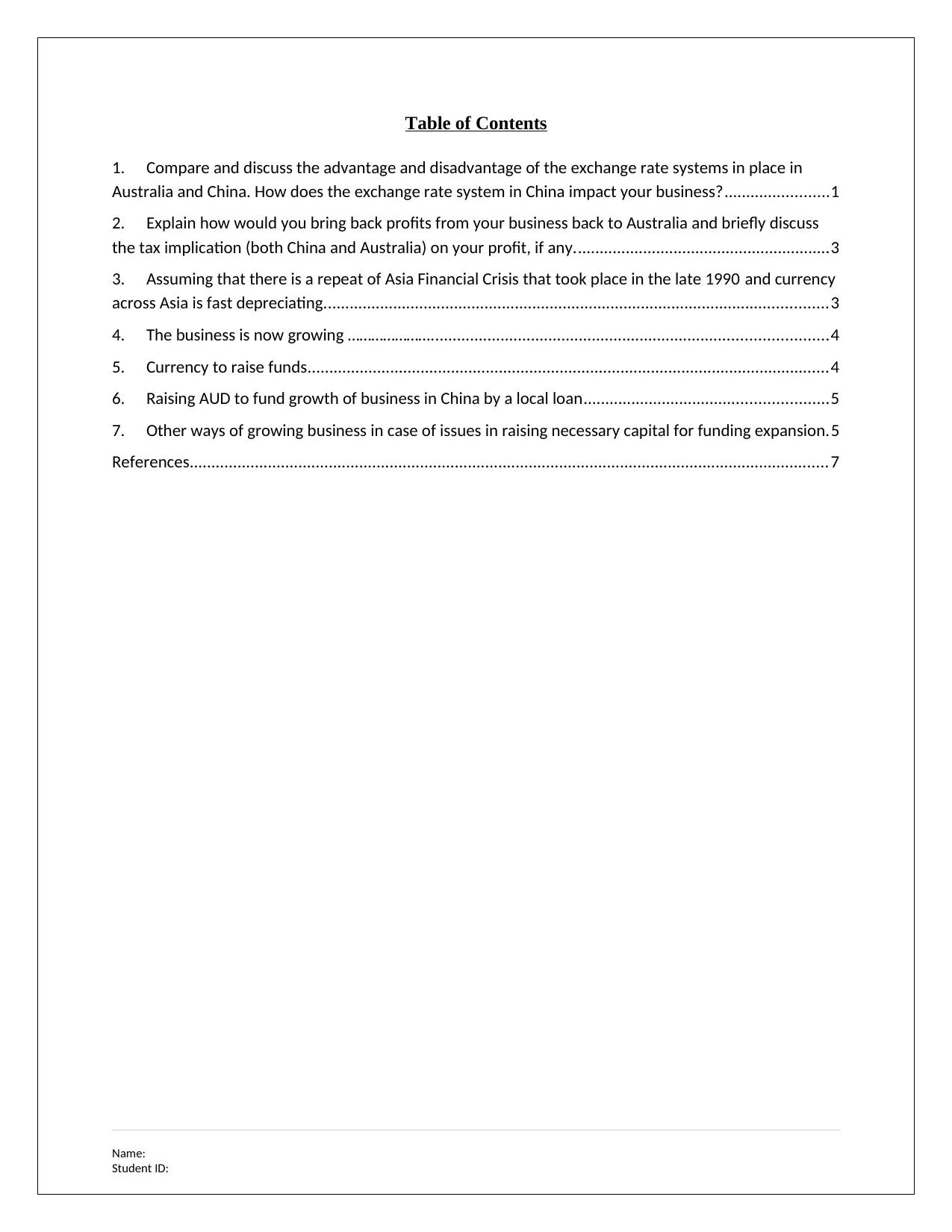
Table of Contents
1. Compare and discuss the advantage and disadvantage of the exchange rate systems in place in
Australia and China. How does the exchange rate system in China impact your business?........................1
2. Explain how would you bring back profits from your business back to Australia and briefly discuss
the tax implication (both China and Australia) on your profit, if any...........................................................3
3. Assuming that there is a repeat of Asia Financial Crisis that took place in the late 1990 and currency
across Asia is fast depreciating....................................................................................................................3
4. The business is now growing …………………...........................................................................................4
5. Currency to raise funds........................................................................................................................4
6. Raising AUD to fund growth of business in China by a local loan........................................................5
7. Other ways of growing business in case of issues in raising necessary capital for funding expansion.5
References...................................................................................................................................................7
Name:
Student ID:
1. Compare and discuss the advantage and disadvantage of the exchange rate systems in place in
Australia and China. How does the exchange rate system in China impact your business?........................1
2. Explain how would you bring back profits from your business back to Australia and briefly discuss
the tax implication (both China and Australia) on your profit, if any...........................................................3
3. Assuming that there is a repeat of Asia Financial Crisis that took place in the late 1990 and currency
across Asia is fast depreciating....................................................................................................................3
4. The business is now growing …………………...........................................................................................4
5. Currency to raise funds........................................................................................................................4
6. Raising AUD to fund growth of business in China by a local loan........................................................5
7. Other ways of growing business in case of issues in raising necessary capital for funding expansion.5
References...................................................................................................................................................7
Name:
Student ID:
Paraphrase This Document
Need a fresh take? Get an instant paraphrase of this document with our AI Paraphraser
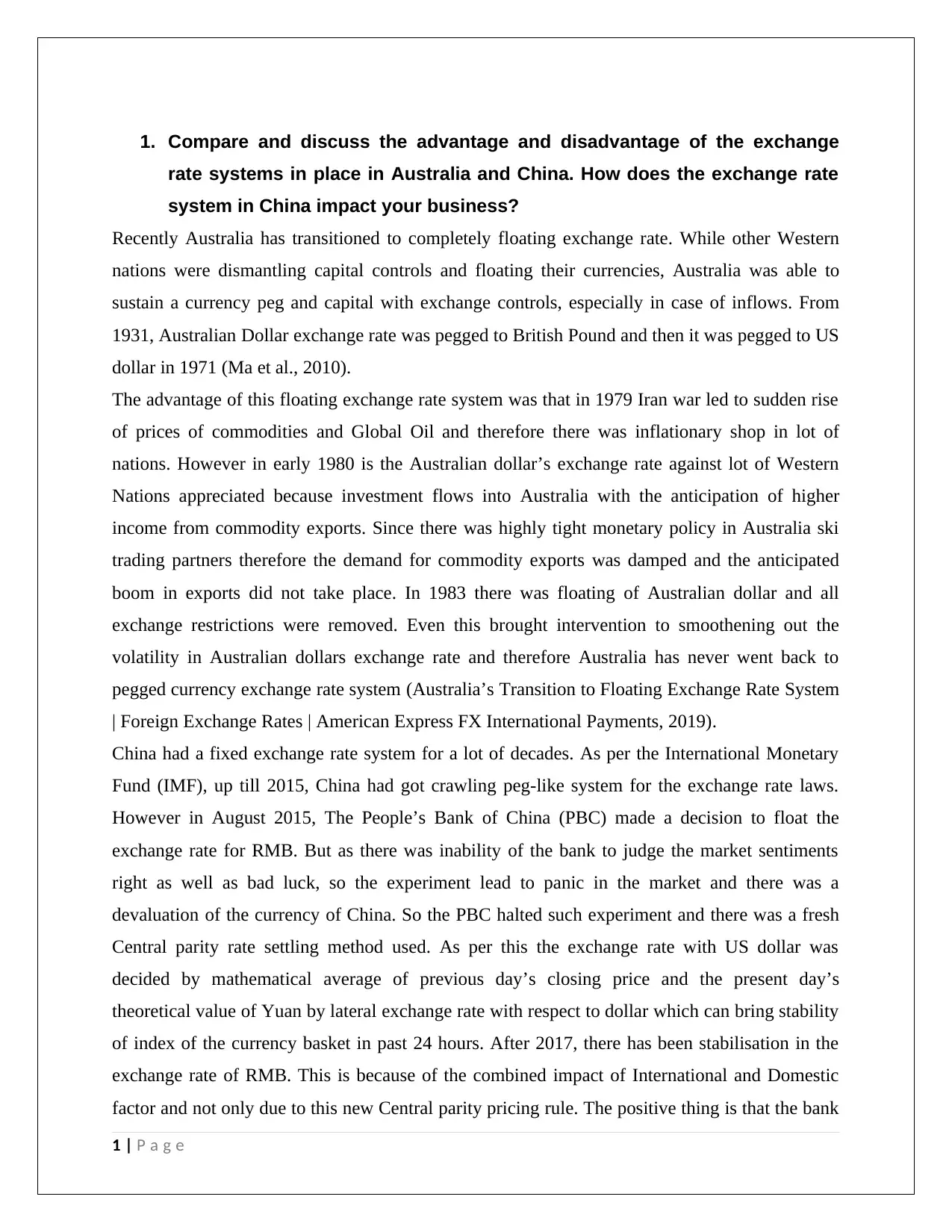
1. Compare and discuss the advantage and disadvantage of the exchange
rate systems in place in Australia and China. How does the exchange rate
system in China impact your business?
Recently Australia has transitioned to completely floating exchange rate. While other Western
nations were dismantling capital controls and floating their currencies, Australia was able to
sustain a currency peg and capital with exchange controls, especially in case of inflows. From
1931, Australian Dollar exchange rate was pegged to British Pound and then it was pegged to US
dollar in 1971 (Ma et al., 2010).
The advantage of this floating exchange rate system was that in 1979 Iran war led to sudden rise
of prices of commodities and Global Oil and therefore there was inflationary shop in lot of
nations. However in early 1980 is the Australian dollar’s exchange rate against lot of Western
Nations appreciated because investment flows into Australia with the anticipation of higher
income from commodity exports. Since there was highly tight monetary policy in Australia ski
trading partners therefore the demand for commodity exports was damped and the anticipated
boom in exports did not take place. In 1983 there was floating of Australian dollar and all
exchange restrictions were removed. Even this brought intervention to smoothening out the
volatility in Australian dollars exchange rate and therefore Australia has never went back to
pegged currency exchange rate system (Australia’s Transition to Floating Exchange Rate System
| Foreign Exchange Rates | American Express FX International Payments, 2019).
China had a fixed exchange rate system for a lot of decades. As per the International Monetary
Fund (IMF), up till 2015, China had got crawling peg-like system for the exchange rate laws.
However in August 2015, The People’s Bank of China (PBC) made a decision to float the
exchange rate for RMB. But as there was inability of the bank to judge the market sentiments
right as well as bad luck, so the experiment lead to panic in the market and there was a
devaluation of the currency of China. So the PBC halted such experiment and there was a fresh
Central parity rate settling method used. As per this the exchange rate with US dollar was
decided by mathematical average of previous day’s closing price and the present day’s
theoretical value of Yuan by lateral exchange rate with respect to dollar which can bring stability
of index of the currency basket in past 24 hours. After 2017, there has been stabilisation in the
exchange rate of RMB. This is because of the combined impact of International and Domestic
factor and not only due to this new Central parity pricing rule. The positive thing is that the bank
1 | P a g e
rate systems in place in Australia and China. How does the exchange rate
system in China impact your business?
Recently Australia has transitioned to completely floating exchange rate. While other Western
nations were dismantling capital controls and floating their currencies, Australia was able to
sustain a currency peg and capital with exchange controls, especially in case of inflows. From
1931, Australian Dollar exchange rate was pegged to British Pound and then it was pegged to US
dollar in 1971 (Ma et al., 2010).
The advantage of this floating exchange rate system was that in 1979 Iran war led to sudden rise
of prices of commodities and Global Oil and therefore there was inflationary shop in lot of
nations. However in early 1980 is the Australian dollar’s exchange rate against lot of Western
Nations appreciated because investment flows into Australia with the anticipation of higher
income from commodity exports. Since there was highly tight monetary policy in Australia ski
trading partners therefore the demand for commodity exports was damped and the anticipated
boom in exports did not take place. In 1983 there was floating of Australian dollar and all
exchange restrictions were removed. Even this brought intervention to smoothening out the
volatility in Australian dollars exchange rate and therefore Australia has never went back to
pegged currency exchange rate system (Australia’s Transition to Floating Exchange Rate System
| Foreign Exchange Rates | American Express FX International Payments, 2019).
China had a fixed exchange rate system for a lot of decades. As per the International Monetary
Fund (IMF), up till 2015, China had got crawling peg-like system for the exchange rate laws.
However in August 2015, The People’s Bank of China (PBC) made a decision to float the
exchange rate for RMB. But as there was inability of the bank to judge the market sentiments
right as well as bad luck, so the experiment lead to panic in the market and there was a
devaluation of the currency of China. So the PBC halted such experiment and there was a fresh
Central parity rate settling method used. As per this the exchange rate with US dollar was
decided by mathematical average of previous day’s closing price and the present day’s
theoretical value of Yuan by lateral exchange rate with respect to dollar which can bring stability
of index of the currency basket in past 24 hours. After 2017, there has been stabilisation in the
exchange rate of RMB. This is because of the combined impact of International and Domestic
factor and not only due to this new Central parity pricing rule. The positive thing is that the bank
1 | P a g e
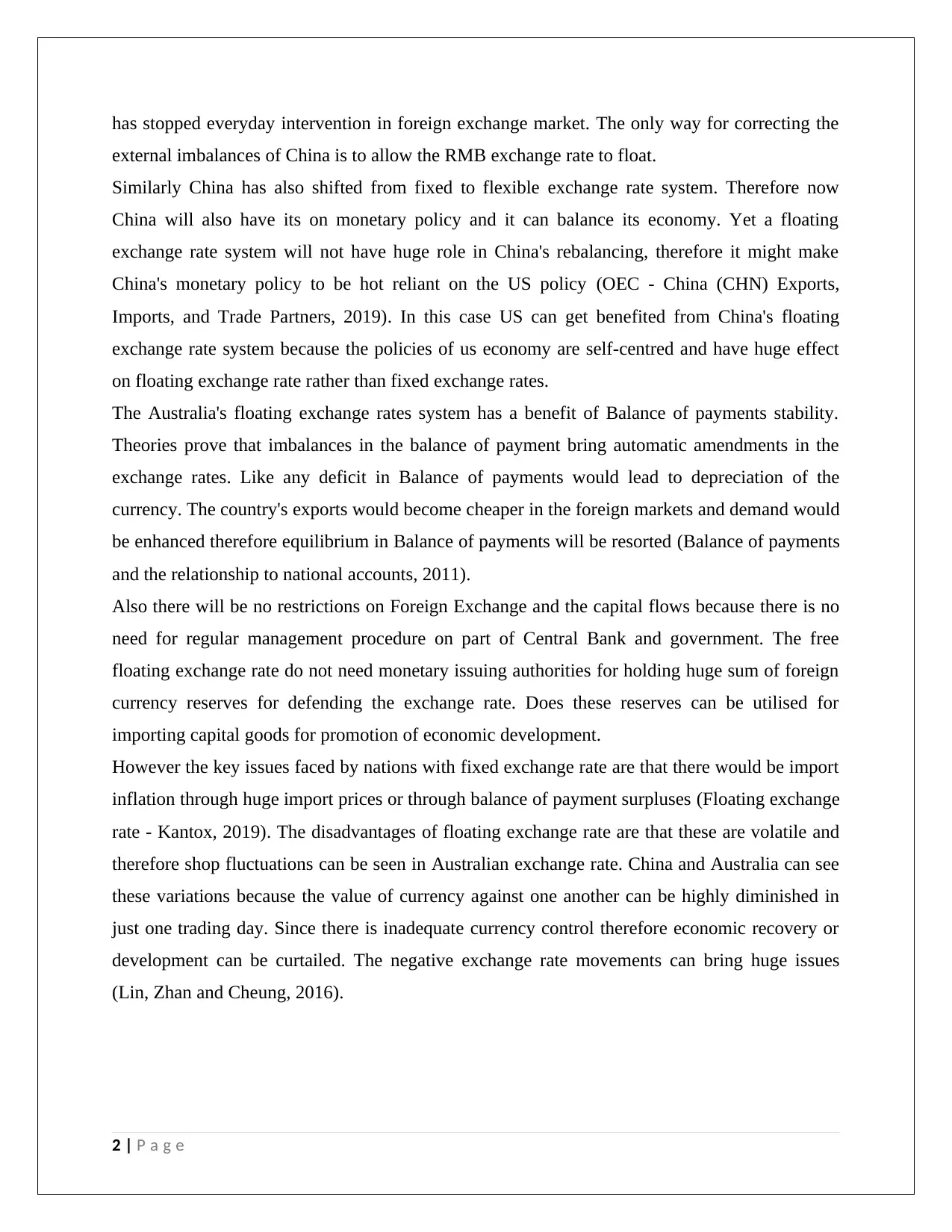
has stopped everyday intervention in foreign exchange market. The only way for correcting the
external imbalances of China is to allow the RMB exchange rate to float.
Similarly China has also shifted from fixed to flexible exchange rate system. Therefore now
China will also have its on monetary policy and it can balance its economy. Yet a floating
exchange rate system will not have huge role in China's rebalancing, therefore it might make
China's monetary policy to be hot reliant on the US policy (OEC - China (CHN) Exports,
Imports, and Trade Partners, 2019). In this case US can get benefited from China's floating
exchange rate system because the policies of us economy are self-centred and have huge effect
on floating exchange rate rather than fixed exchange rates.
The Australia's floating exchange rates system has a benefit of Balance of payments stability.
Theories prove that imbalances in the balance of payment bring automatic amendments in the
exchange rates. Like any deficit in Balance of payments would lead to depreciation of the
currency. The country's exports would become cheaper in the foreign markets and demand would
be enhanced therefore equilibrium in Balance of payments will be resorted (Balance of payments
and the relationship to national accounts, 2011).
Also there will be no restrictions on Foreign Exchange and the capital flows because there is no
need for regular management procedure on part of Central Bank and government. The free
floating exchange rate do not need monetary issuing authorities for holding huge sum of foreign
currency reserves for defending the exchange rate. Does these reserves can be utilised for
importing capital goods for promotion of economic development.
However the key issues faced by nations with fixed exchange rate are that there would be import
inflation through huge import prices or through balance of payment surpluses (Floating exchange
rate - Kantox, 2019). The disadvantages of floating exchange rate are that these are volatile and
therefore shop fluctuations can be seen in Australian exchange rate. China and Australia can see
these variations because the value of currency against one another can be highly diminished in
just one trading day. Since there is inadequate currency control therefore economic recovery or
development can be curtailed. The negative exchange rate movements can bring huge issues
(Lin, Zhan and Cheung, 2016).
2 | P a g e
external imbalances of China is to allow the RMB exchange rate to float.
Similarly China has also shifted from fixed to flexible exchange rate system. Therefore now
China will also have its on monetary policy and it can balance its economy. Yet a floating
exchange rate system will not have huge role in China's rebalancing, therefore it might make
China's monetary policy to be hot reliant on the US policy (OEC - China (CHN) Exports,
Imports, and Trade Partners, 2019). In this case US can get benefited from China's floating
exchange rate system because the policies of us economy are self-centred and have huge effect
on floating exchange rate rather than fixed exchange rates.
The Australia's floating exchange rates system has a benefit of Balance of payments stability.
Theories prove that imbalances in the balance of payment bring automatic amendments in the
exchange rates. Like any deficit in Balance of payments would lead to depreciation of the
currency. The country's exports would become cheaper in the foreign markets and demand would
be enhanced therefore equilibrium in Balance of payments will be resorted (Balance of payments
and the relationship to national accounts, 2011).
Also there will be no restrictions on Foreign Exchange and the capital flows because there is no
need for regular management procedure on part of Central Bank and government. The free
floating exchange rate do not need monetary issuing authorities for holding huge sum of foreign
currency reserves for defending the exchange rate. Does these reserves can be utilised for
importing capital goods for promotion of economic development.
However the key issues faced by nations with fixed exchange rate are that there would be import
inflation through huge import prices or through balance of payment surpluses (Floating exchange
rate - Kantox, 2019). The disadvantages of floating exchange rate are that these are volatile and
therefore shop fluctuations can be seen in Australian exchange rate. China and Australia can see
these variations because the value of currency against one another can be highly diminished in
just one trading day. Since there is inadequate currency control therefore economic recovery or
development can be curtailed. The negative exchange rate movements can bring huge issues
(Lin, Zhan and Cheung, 2016).
2 | P a g e
⊘ This is a preview!⊘
Do you want full access?
Subscribe today to unlock all pages.

Trusted by 1+ million students worldwide
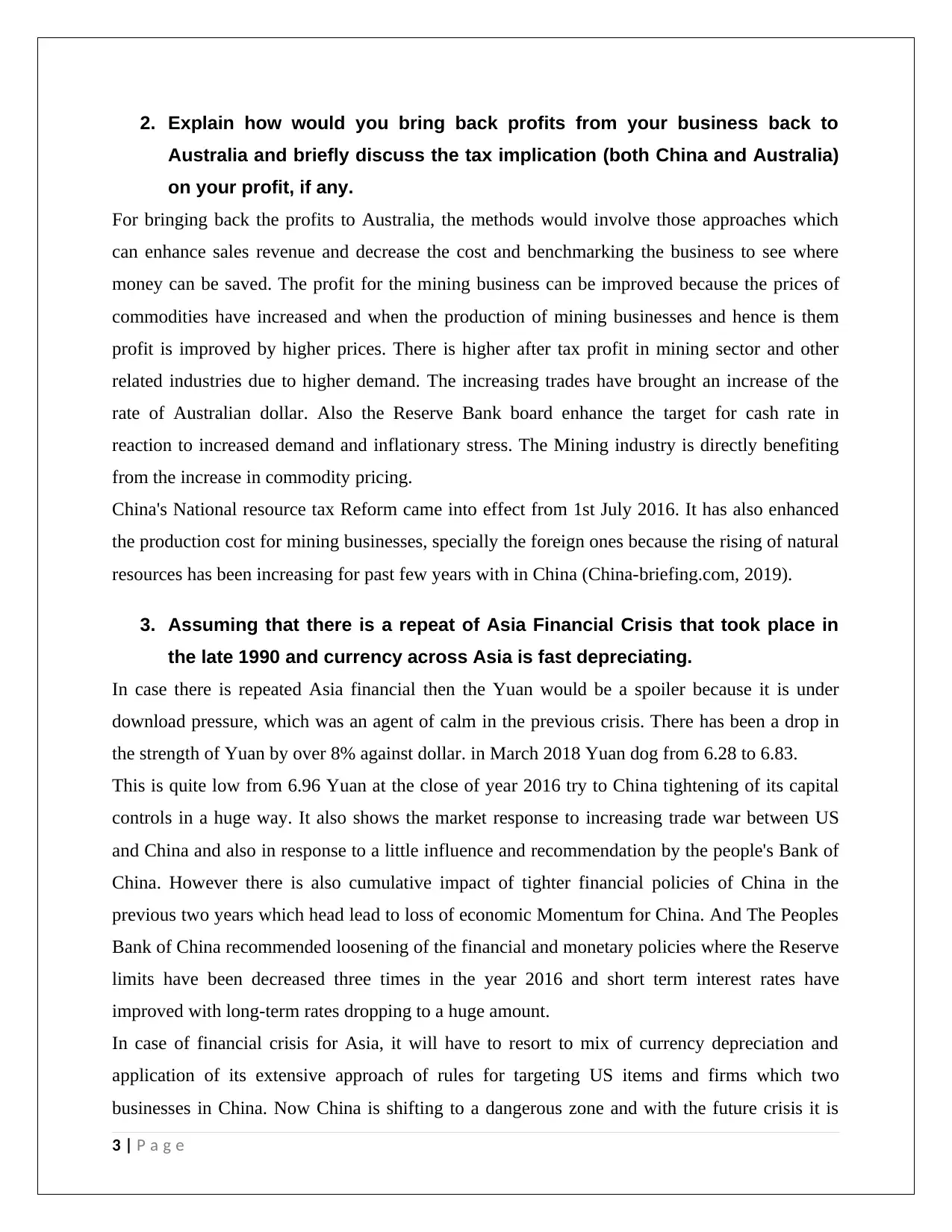
2. Explain how would you bring back profits from your business back to
Australia and briefly discuss the tax implication (both China and Australia)
on your profit, if any.
For bringing back the profits to Australia, the methods would involve those approaches which
can enhance sales revenue and decrease the cost and benchmarking the business to see where
money can be saved. The profit for the mining business can be improved because the prices of
commodities have increased and when the production of mining businesses and hence is them
profit is improved by higher prices. There is higher after tax profit in mining sector and other
related industries due to higher demand. The increasing trades have brought an increase of the
rate of Australian dollar. Also the Reserve Bank board enhance the target for cash rate in
reaction to increased demand and inflationary stress. The Mining industry is directly benefiting
from the increase in commodity pricing.
China's National resource tax Reform came into effect from 1st July 2016. It has also enhanced
the production cost for mining businesses, specially the foreign ones because the rising of natural
resources has been increasing for past few years with in China (China-briefing.com, 2019).
3. Assuming that there is a repeat of Asia Financial Crisis that took place in
the late 1990 and currency across Asia is fast depreciating.
In case there is repeated Asia financial then the Yuan would be a spoiler because it is under
download pressure, which was an agent of calm in the previous crisis. There has been a drop in
the strength of Yuan by over 8% against dollar. in March 2018 Yuan dog from 6.28 to 6.83.
This is quite low from 6.96 Yuan at the close of year 2016 try to China tightening of its capital
controls in a huge way. It also shows the market response to increasing trade war between US
and China and also in response to a little influence and recommendation by the people's Bank of
China. However there is also cumulative impact of tighter financial policies of China in the
previous two years which head lead to loss of economic Momentum for China. And The Peoples
Bank of China recommended loosening of the financial and monetary policies where the Reserve
limits have been decreased three times in the year 2016 and short term interest rates have
improved with long-term rates dropping to a huge amount.
In case of financial crisis for Asia, it will have to resort to mix of currency depreciation and
application of its extensive approach of rules for targeting US items and firms which two
businesses in China. Now China is shifting to a dangerous zone and with the future crisis it is
3 | P a g e
Australia and briefly discuss the tax implication (both China and Australia)
on your profit, if any.
For bringing back the profits to Australia, the methods would involve those approaches which
can enhance sales revenue and decrease the cost and benchmarking the business to see where
money can be saved. The profit for the mining business can be improved because the prices of
commodities have increased and when the production of mining businesses and hence is them
profit is improved by higher prices. There is higher after tax profit in mining sector and other
related industries due to higher demand. The increasing trades have brought an increase of the
rate of Australian dollar. Also the Reserve Bank board enhance the target for cash rate in
reaction to increased demand and inflationary stress. The Mining industry is directly benefiting
from the increase in commodity pricing.
China's National resource tax Reform came into effect from 1st July 2016. It has also enhanced
the production cost for mining businesses, specially the foreign ones because the rising of natural
resources has been increasing for past few years with in China (China-briefing.com, 2019).
3. Assuming that there is a repeat of Asia Financial Crisis that took place in
the late 1990 and currency across Asia is fast depreciating.
In case there is repeated Asia financial then the Yuan would be a spoiler because it is under
download pressure, which was an agent of calm in the previous crisis. There has been a drop in
the strength of Yuan by over 8% against dollar. in March 2018 Yuan dog from 6.28 to 6.83.
This is quite low from 6.96 Yuan at the close of year 2016 try to China tightening of its capital
controls in a huge way. It also shows the market response to increasing trade war between US
and China and also in response to a little influence and recommendation by the people's Bank of
China. However there is also cumulative impact of tighter financial policies of China in the
previous two years which head lead to loss of economic Momentum for China. And The Peoples
Bank of China recommended loosening of the financial and monetary policies where the Reserve
limits have been decreased three times in the year 2016 and short term interest rates have
improved with long-term rates dropping to a huge amount.
In case of financial crisis for Asia, it will have to resort to mix of currency depreciation and
application of its extensive approach of rules for targeting US items and firms which two
businesses in China. Now China is shifting to a dangerous zone and with the future crisis it is
3 | P a g e
Paraphrase This Document
Need a fresh take? Get an instant paraphrase of this document with our AI Paraphraser
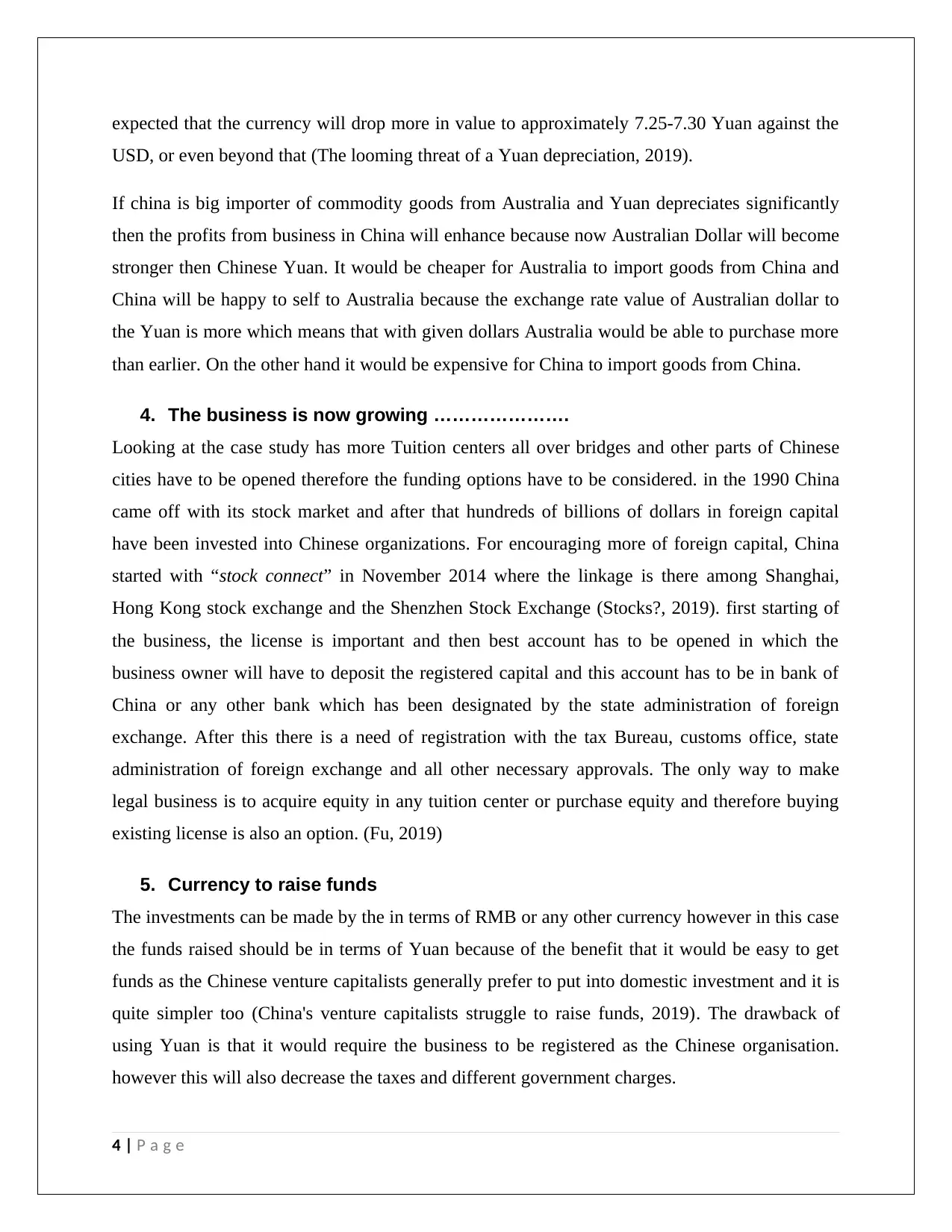
expected that the currency will drop more in value to approximately 7.25-7.30 Yuan against the
USD, or even beyond that (The looming threat of a Yuan depreciation, 2019).
If china is big importer of commodity goods from Australia and Yuan depreciates significantly
then the profits from business in China will enhance because now Australian Dollar will become
stronger then Chinese Yuan. It would be cheaper for Australia to import goods from China and
China will be happy to self to Australia because the exchange rate value of Australian dollar to
the Yuan is more which means that with given dollars Australia would be able to purchase more
than earlier. On the other hand it would be expensive for China to import goods from China.
4. The business is now growing ………………….
Looking at the case study has more Tuition centers all over bridges and other parts of Chinese
cities have to be opened therefore the funding options have to be considered. in the 1990 China
came off with its stock market and after that hundreds of billions of dollars in foreign capital
have been invested into Chinese organizations. For encouraging more of foreign capital, China
started with “stock connect” in November 2014 where the linkage is there among Shanghai,
Hong Kong stock exchange and the Shenzhen Stock Exchange (Stocks?, 2019). first starting of
the business, the license is important and then best account has to be opened in which the
business owner will have to deposit the registered capital and this account has to be in bank of
China or any other bank which has been designated by the state administration of foreign
exchange. After this there is a need of registration with the tax Bureau, customs office, state
administration of foreign exchange and all other necessary approvals. The only way to make
legal business is to acquire equity in any tuition center or purchase equity and therefore buying
existing license is also an option. (Fu, 2019)
5. Currency to raise funds
The investments can be made by the in terms of RMB or any other currency however in this case
the funds raised should be in terms of Yuan because of the benefit that it would be easy to get
funds as the Chinese venture capitalists generally prefer to put into domestic investment and it is
quite simpler too (China's venture capitalists struggle to raise funds, 2019). The drawback of
using Yuan is that it would require the business to be registered as the Chinese organisation.
however this will also decrease the taxes and different government charges.
4 | P a g e
USD, or even beyond that (The looming threat of a Yuan depreciation, 2019).
If china is big importer of commodity goods from Australia and Yuan depreciates significantly
then the profits from business in China will enhance because now Australian Dollar will become
stronger then Chinese Yuan. It would be cheaper for Australia to import goods from China and
China will be happy to self to Australia because the exchange rate value of Australian dollar to
the Yuan is more which means that with given dollars Australia would be able to purchase more
than earlier. On the other hand it would be expensive for China to import goods from China.
4. The business is now growing ………………….
Looking at the case study has more Tuition centers all over bridges and other parts of Chinese
cities have to be opened therefore the funding options have to be considered. in the 1990 China
came off with its stock market and after that hundreds of billions of dollars in foreign capital
have been invested into Chinese organizations. For encouraging more of foreign capital, China
started with “stock connect” in November 2014 where the linkage is there among Shanghai,
Hong Kong stock exchange and the Shenzhen Stock Exchange (Stocks?, 2019). first starting of
the business, the license is important and then best account has to be opened in which the
business owner will have to deposit the registered capital and this account has to be in bank of
China or any other bank which has been designated by the state administration of foreign
exchange. After this there is a need of registration with the tax Bureau, customs office, state
administration of foreign exchange and all other necessary approvals. The only way to make
legal business is to acquire equity in any tuition center or purchase equity and therefore buying
existing license is also an option. (Fu, 2019)
5. Currency to raise funds
The investments can be made by the in terms of RMB or any other currency however in this case
the funds raised should be in terms of Yuan because of the benefit that it would be easy to get
funds as the Chinese venture capitalists generally prefer to put into domestic investment and it is
quite simpler too (China's venture capitalists struggle to raise funds, 2019). The drawback of
using Yuan is that it would require the business to be registered as the Chinese organisation.
however this will also decrease the taxes and different government charges.
4 | P a g e
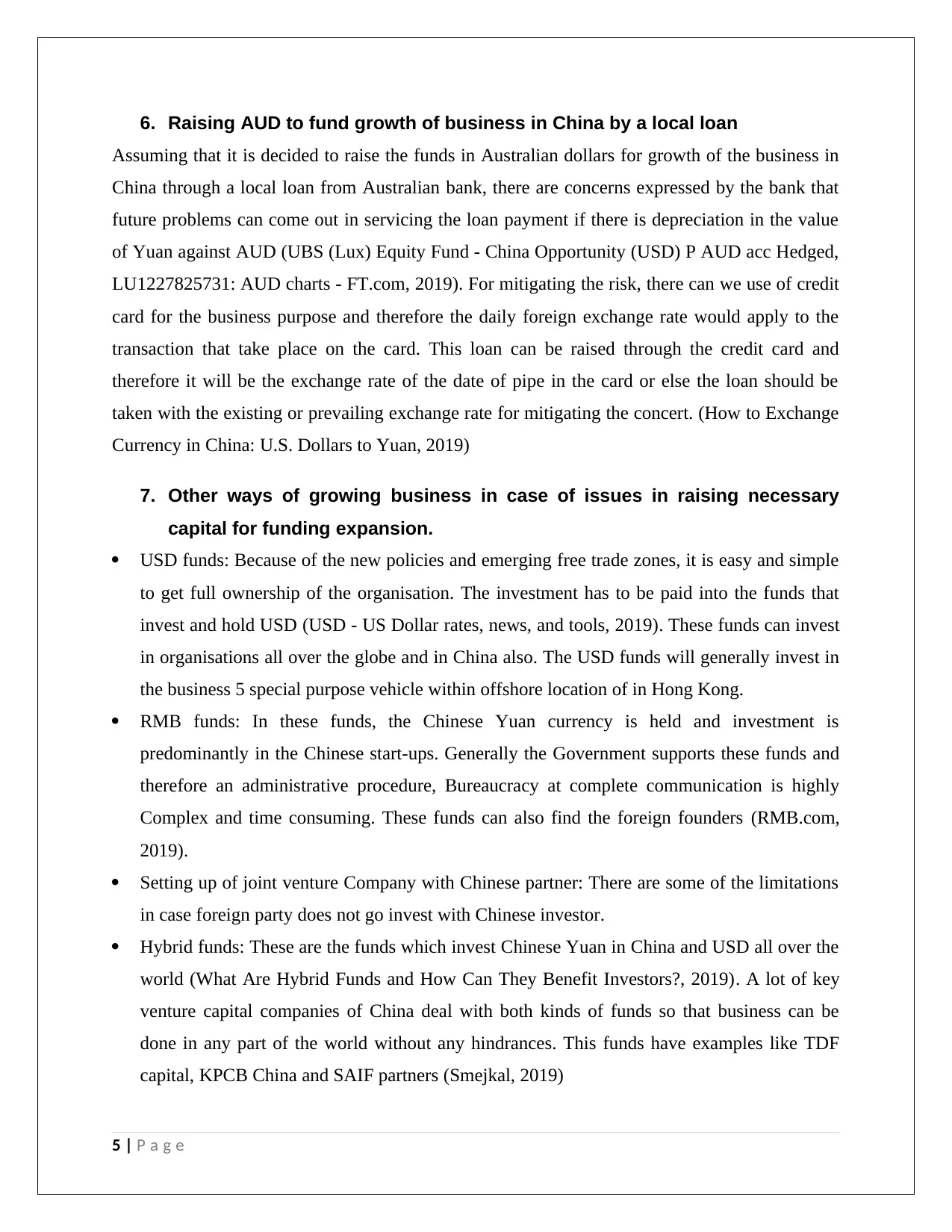
6. Raising AUD to fund growth of business in China by a local loan
Assuming that it is decided to raise the funds in Australian dollars for growth of the business in
China through a local loan from Australian bank, there are concerns expressed by the bank that
future problems can come out in servicing the loan payment if there is depreciation in the value
of Yuan against AUD (UBS (Lux) Equity Fund - China Opportunity (USD) P AUD acc Hedged,
LU1227825731: AUD charts - FT.com, 2019). For mitigating the risk, there can we use of credit
card for the business purpose and therefore the daily foreign exchange rate would apply to the
transaction that take place on the card. This loan can be raised through the credit card and
therefore it will be the exchange rate of the date of pipe in the card or else the loan should be
taken with the existing or prevailing exchange rate for mitigating the concert. (How to Exchange
Currency in China: U.S. Dollars to Yuan, 2019)
7. Other ways of growing business in case of issues in raising necessary
capital for funding expansion.
USD funds: Because of the new policies and emerging free trade zones, it is easy and simple
to get full ownership of the organisation. The investment has to be paid into the funds that
invest and hold USD (USD - US Dollar rates, news, and tools, 2019). These funds can invest
in organisations all over the globe and in China also. The USD funds will generally invest in
the business 5 special purpose vehicle within offshore location of in Hong Kong.
RMB funds: In these funds, the Chinese Yuan currency is held and investment is
predominantly in the Chinese start-ups. Generally the Government supports these funds and
therefore an administrative procedure, Bureaucracy at complete communication is highly
Complex and time consuming. These funds can also find the foreign founders (RMB.com,
2019).
Setting up of joint venture Company with Chinese partner: There are some of the limitations
in case foreign party does not go invest with Chinese investor.
Hybrid funds: These are the funds which invest Chinese Yuan in China and USD all over the
world (What Are Hybrid Funds and How Can They Benefit Investors?, 2019). A lot of key
venture capital companies of China deal with both kinds of funds so that business can be
done in any part of the world without any hindrances. This funds have examples like TDF
capital, KPCB China and SAIF partners (Smejkal, 2019)
5 | P a g e
Assuming that it is decided to raise the funds in Australian dollars for growth of the business in
China through a local loan from Australian bank, there are concerns expressed by the bank that
future problems can come out in servicing the loan payment if there is depreciation in the value
of Yuan against AUD (UBS (Lux) Equity Fund - China Opportunity (USD) P AUD acc Hedged,
LU1227825731: AUD charts - FT.com, 2019). For mitigating the risk, there can we use of credit
card for the business purpose and therefore the daily foreign exchange rate would apply to the
transaction that take place on the card. This loan can be raised through the credit card and
therefore it will be the exchange rate of the date of pipe in the card or else the loan should be
taken with the existing or prevailing exchange rate for mitigating the concert. (How to Exchange
Currency in China: U.S. Dollars to Yuan, 2019)
7. Other ways of growing business in case of issues in raising necessary
capital for funding expansion.
USD funds: Because of the new policies and emerging free trade zones, it is easy and simple
to get full ownership of the organisation. The investment has to be paid into the funds that
invest and hold USD (USD - US Dollar rates, news, and tools, 2019). These funds can invest
in organisations all over the globe and in China also. The USD funds will generally invest in
the business 5 special purpose vehicle within offshore location of in Hong Kong.
RMB funds: In these funds, the Chinese Yuan currency is held and investment is
predominantly in the Chinese start-ups. Generally the Government supports these funds and
therefore an administrative procedure, Bureaucracy at complete communication is highly
Complex and time consuming. These funds can also find the foreign founders (RMB.com,
2019).
Setting up of joint venture Company with Chinese partner: There are some of the limitations
in case foreign party does not go invest with Chinese investor.
Hybrid funds: These are the funds which invest Chinese Yuan in China and USD all over the
world (What Are Hybrid Funds and How Can They Benefit Investors?, 2019). A lot of key
venture capital companies of China deal with both kinds of funds so that business can be
done in any part of the world without any hindrances. This funds have examples like TDF
capital, KPCB China and SAIF partners (Smejkal, 2019)
5 | P a g e
⊘ This is a preview!⊘
Do you want full access?
Subscribe today to unlock all pages.

Trusted by 1+ million students worldwide
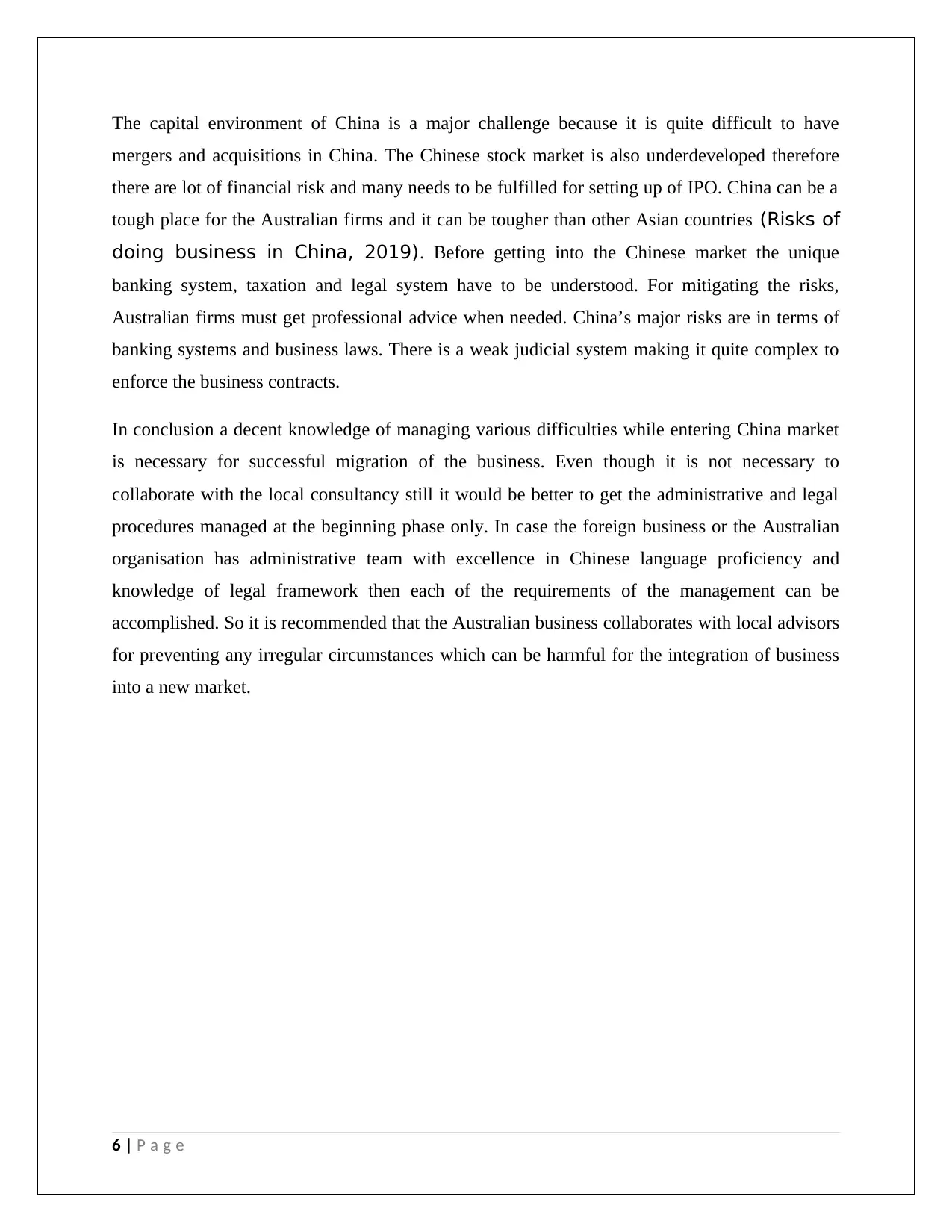
The capital environment of China is a major challenge because it is quite difficult to have
mergers and acquisitions in China. The Chinese stock market is also underdeveloped therefore
there are lot of financial risk and many needs to be fulfilled for setting up of IPO. China can be a
tough place for the Australian firms and it can be tougher than other Asian countries (Risks of
doing business in China, 2019). Before getting into the Chinese market the unique
banking system, taxation and legal system have to be understood. For mitigating the risks,
Australian firms must get professional advice when needed. China’s major risks are in terms of
banking systems and business laws. There is a weak judicial system making it quite complex to
enforce the business contracts.
In conclusion a decent knowledge of managing various difficulties while entering China market
is necessary for successful migration of the business. Even though it is not necessary to
collaborate with the local consultancy still it would be better to get the administrative and legal
procedures managed at the beginning phase only. In case the foreign business or the Australian
organisation has administrative team with excellence in Chinese language proficiency and
knowledge of legal framework then each of the requirements of the management can be
accomplished. So it is recommended that the Australian business collaborates with local advisors
for preventing any irregular circumstances which can be harmful for the integration of business
into a new market.
6 | P a g e
mergers and acquisitions in China. The Chinese stock market is also underdeveloped therefore
there are lot of financial risk and many needs to be fulfilled for setting up of IPO. China can be a
tough place for the Australian firms and it can be tougher than other Asian countries (Risks of
doing business in China, 2019). Before getting into the Chinese market the unique
banking system, taxation and legal system have to be understood. For mitigating the risks,
Australian firms must get professional advice when needed. China’s major risks are in terms of
banking systems and business laws. There is a weak judicial system making it quite complex to
enforce the business contracts.
In conclusion a decent knowledge of managing various difficulties while entering China market
is necessary for successful migration of the business. Even though it is not necessary to
collaborate with the local consultancy still it would be better to get the administrative and legal
procedures managed at the beginning phase only. In case the foreign business or the Australian
organisation has administrative team with excellence in Chinese language proficiency and
knowledge of legal framework then each of the requirements of the management can be
accomplished. So it is recommended that the Australian business collaborates with local advisors
for preventing any irregular circumstances which can be harmful for the integration of business
into a new market.
6 | P a g e
Paraphrase This Document
Need a fresh take? Get an instant paraphrase of this document with our AI Paraphraser
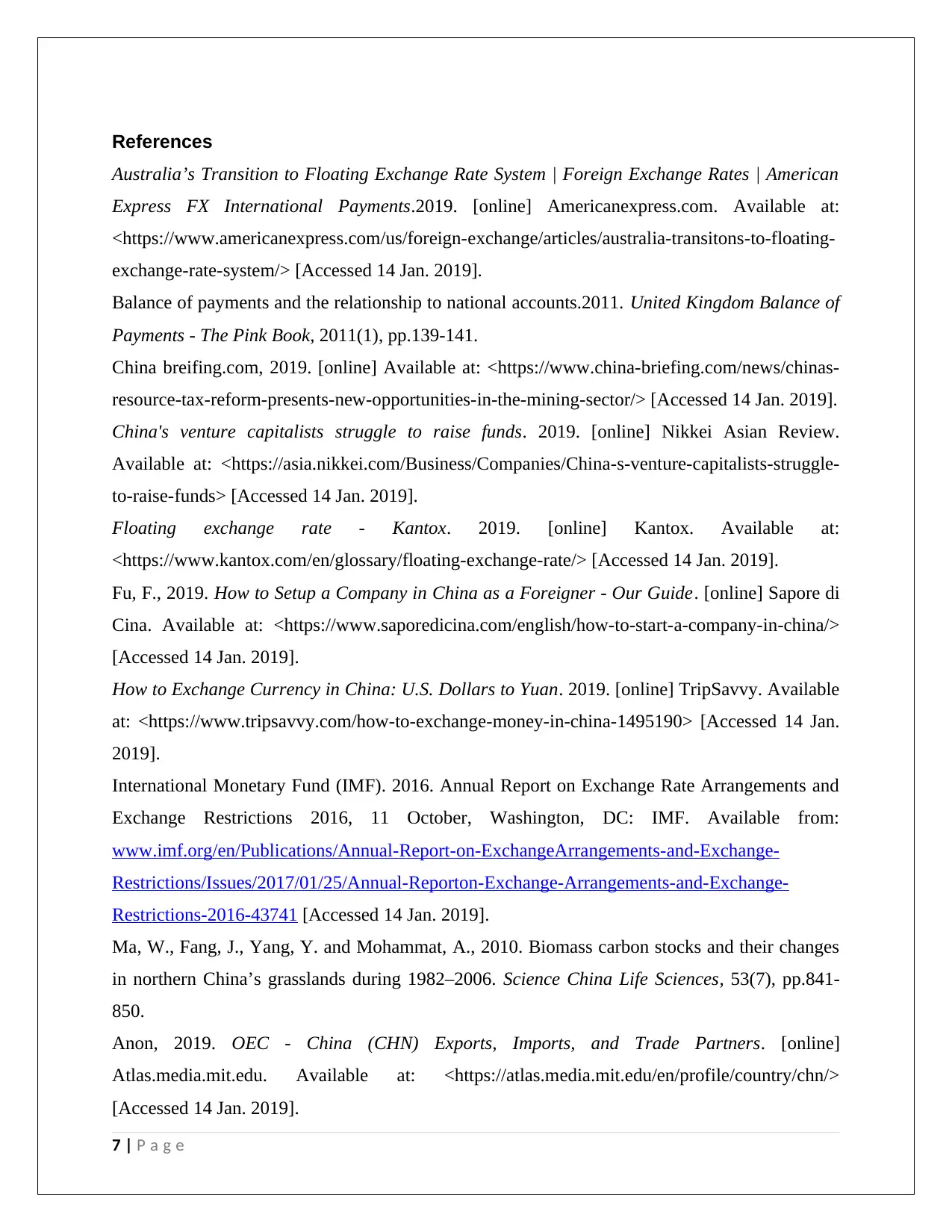
References
Australia’s Transition to Floating Exchange Rate System | Foreign Exchange Rates | American
Express FX International Payments.2019. [online] Americanexpress.com. Available at:
<https://www.americanexpress.com/us/foreign-exchange/articles/australia-transitons-to-floating-
exchange-rate-system/> [Accessed 14 Jan. 2019].
Balance of payments and the relationship to national accounts.2011. United Kingdom Balance of
Payments - The Pink Book, 2011(1), pp.139-141.
China breifing.com, 2019. [online] Available at: <https://www.china-briefing.com/news/chinas-
resource-tax-reform-presents-new-opportunities-in-the-mining-sector/> [Accessed 14 Jan. 2019].
China's venture capitalists struggle to raise funds. 2019. [online] Nikkei Asian Review.
Available at: <https://asia.nikkei.com/Business/Companies/China-s-venture-capitalists-struggle-
to-raise-funds> [Accessed 14 Jan. 2019].
Floating exchange rate - Kantox. 2019. [online] Kantox. Available at:
<https://www.kantox.com/en/glossary/floating-exchange-rate/> [Accessed 14 Jan. 2019].
Fu, F., 2019. How to Setup a Company in China as a Foreigner - Our Guide. [online] Sapore di
Cina. Available at: <https://www.saporedicina.com/english/how-to-start-a-company-in-china/>
[Accessed 14 Jan. 2019].
How to Exchange Currency in China: U.S. Dollars to Yuan. 2019. [online] TripSavvy. Available
at: <https://www.tripsavvy.com/how-to-exchange-money-in-china-1495190> [Accessed 14 Jan.
2019].
International Monetary Fund (IMF). 2016. Annual Report on Exchange Rate Arrangements and
Exchange Restrictions 2016, 11 October, Washington, DC: IMF. Available from:
www.imf.org/en/Publications/Annual-Report-on-ExchangeArrangements-and-Exchange-
Restrictions/Issues/2017/01/25/Annual-Reporton-Exchange-Arrangements-and-Exchange-
Restrictions-2016-43741 [Accessed 14 Jan. 2019].
Ma, W., Fang, J., Yang, Y. and Mohammat, A., 2010. Biomass carbon stocks and their changes
in northern China’s grasslands during 1982–2006. Science China Life Sciences, 53(7), pp.841-
850.
Anon, 2019. OEC - China (CHN) Exports, Imports, and Trade Partners. [online]
Atlas.media.mit.edu. Available at: <https://atlas.media.mit.edu/en/profile/country/chn/>
[Accessed 14 Jan. 2019].
7 | P a g e
Australia’s Transition to Floating Exchange Rate System | Foreign Exchange Rates | American
Express FX International Payments.2019. [online] Americanexpress.com. Available at:
<https://www.americanexpress.com/us/foreign-exchange/articles/australia-transitons-to-floating-
exchange-rate-system/> [Accessed 14 Jan. 2019].
Balance of payments and the relationship to national accounts.2011. United Kingdom Balance of
Payments - The Pink Book, 2011(1), pp.139-141.
China breifing.com, 2019. [online] Available at: <https://www.china-briefing.com/news/chinas-
resource-tax-reform-presents-new-opportunities-in-the-mining-sector/> [Accessed 14 Jan. 2019].
China's venture capitalists struggle to raise funds. 2019. [online] Nikkei Asian Review.
Available at: <https://asia.nikkei.com/Business/Companies/China-s-venture-capitalists-struggle-
to-raise-funds> [Accessed 14 Jan. 2019].
Floating exchange rate - Kantox. 2019. [online] Kantox. Available at:
<https://www.kantox.com/en/glossary/floating-exchange-rate/> [Accessed 14 Jan. 2019].
Fu, F., 2019. How to Setup a Company in China as a Foreigner - Our Guide. [online] Sapore di
Cina. Available at: <https://www.saporedicina.com/english/how-to-start-a-company-in-china/>
[Accessed 14 Jan. 2019].
How to Exchange Currency in China: U.S. Dollars to Yuan. 2019. [online] TripSavvy. Available
at: <https://www.tripsavvy.com/how-to-exchange-money-in-china-1495190> [Accessed 14 Jan.
2019].
International Monetary Fund (IMF). 2016. Annual Report on Exchange Rate Arrangements and
Exchange Restrictions 2016, 11 October, Washington, DC: IMF. Available from:
www.imf.org/en/Publications/Annual-Report-on-ExchangeArrangements-and-Exchange-
Restrictions/Issues/2017/01/25/Annual-Reporton-Exchange-Arrangements-and-Exchange-
Restrictions-2016-43741 [Accessed 14 Jan. 2019].
Ma, W., Fang, J., Yang, Y. and Mohammat, A., 2010. Biomass carbon stocks and their changes
in northern China’s grasslands during 1982–2006. Science China Life Sciences, 53(7), pp.841-
850.
Anon, 2019. OEC - China (CHN) Exports, Imports, and Trade Partners. [online]
Atlas.media.mit.edu. Available at: <https://atlas.media.mit.edu/en/profile/country/chn/>
[Accessed 14 Jan. 2019].
7 | P a g e
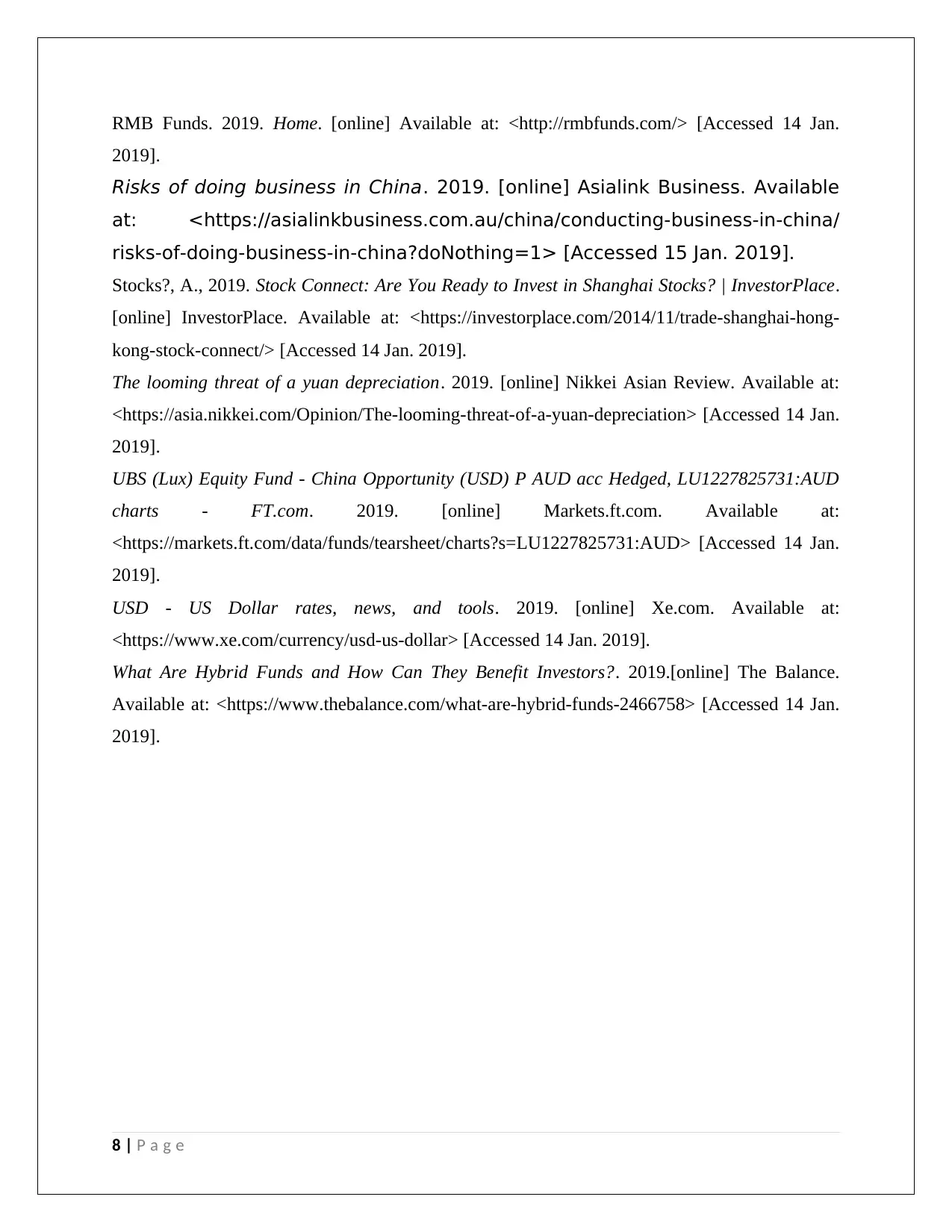
RMB Funds. 2019. Home. [online] Available at: <http://rmbfunds.com/> [Accessed 14 Jan.
2019].
Risks of doing business in China. 2019. [online] Asialink Business. Available
at: <https://asialinkbusiness.com.au/china/conducting-business-in-china/
risks-of-doing-business-in-china?doNothing=1> [Accessed 15 Jan. 2019].
Stocks?, A., 2019. Stock Connect: Are You Ready to Invest in Shanghai Stocks? | InvestorPlace.
[online] InvestorPlace. Available at: <https://investorplace.com/2014/11/trade-shanghai-hong-
kong-stock-connect/> [Accessed 14 Jan. 2019].
The looming threat of a yuan depreciation. 2019. [online] Nikkei Asian Review. Available at:
<https://asia.nikkei.com/Opinion/The-looming-threat-of-a-yuan-depreciation> [Accessed 14 Jan.
2019].
UBS (Lux) Equity Fund - China Opportunity (USD) P AUD acc Hedged, LU1227825731:AUD
charts - FT.com. 2019. [online] Markets.ft.com. Available at:
<https://markets.ft.com/data/funds/tearsheet/charts?s=LU1227825731:AUD> [Accessed 14 Jan.
2019].
USD - US Dollar rates, news, and tools. 2019. [online] Xe.com. Available at:
<https://www.xe.com/currency/usd-us-dollar> [Accessed 14 Jan. 2019].
What Are Hybrid Funds and How Can They Benefit Investors?. 2019.[online] The Balance.
Available at: <https://www.thebalance.com/what-are-hybrid-funds-2466758> [Accessed 14 Jan.
2019].
8 | P a g e
2019].
Risks of doing business in China. 2019. [online] Asialink Business. Available
at: <https://asialinkbusiness.com.au/china/conducting-business-in-china/
risks-of-doing-business-in-china?doNothing=1> [Accessed 15 Jan. 2019].
Stocks?, A., 2019. Stock Connect: Are You Ready to Invest in Shanghai Stocks? | InvestorPlace.
[online] InvestorPlace. Available at: <https://investorplace.com/2014/11/trade-shanghai-hong-
kong-stock-connect/> [Accessed 14 Jan. 2019].
The looming threat of a yuan depreciation. 2019. [online] Nikkei Asian Review. Available at:
<https://asia.nikkei.com/Opinion/The-looming-threat-of-a-yuan-depreciation> [Accessed 14 Jan.
2019].
UBS (Lux) Equity Fund - China Opportunity (USD) P AUD acc Hedged, LU1227825731:AUD
charts - FT.com. 2019. [online] Markets.ft.com. Available at:
<https://markets.ft.com/data/funds/tearsheet/charts?s=LU1227825731:AUD> [Accessed 14 Jan.
2019].
USD - US Dollar rates, news, and tools. 2019. [online] Xe.com. Available at:
<https://www.xe.com/currency/usd-us-dollar> [Accessed 14 Jan. 2019].
What Are Hybrid Funds and How Can They Benefit Investors?. 2019.[online] The Balance.
Available at: <https://www.thebalance.com/what-are-hybrid-funds-2466758> [Accessed 14 Jan.
2019].
8 | P a g e
⊘ This is a preview!⊘
Do you want full access?
Subscribe today to unlock all pages.

Trusted by 1+ million students worldwide
1 out of 9
Related Documents
Your All-in-One AI-Powered Toolkit for Academic Success.
+13062052269
info@desklib.com
Available 24*7 on WhatsApp / Email
![[object Object]](/_next/static/media/star-bottom.7253800d.svg)
Unlock your academic potential
Copyright © 2020–2025 A2Z Services. All Rights Reserved. Developed and managed by ZUCOL.




